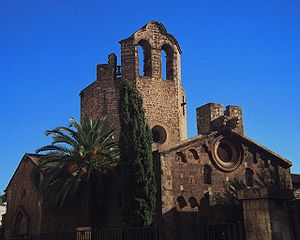
Sant Pau del Camp
Encyclopedia

Catalan language
Catalan is a Romance language, the national and only official language of Andorra and a co-official language in the Spanish autonomous communities of Catalonia, the Balearic Islands and Valencian Community, where it is known as Valencian , as well as in the city of Alghero, on the Italian island...
for "Saint Paul of the countryside" or "in the fields") is a church and former monastery in Barcelona
Barcelona
Barcelona is the second largest city in Spain after Madrid, and the capital of Catalonia, with a population of 1,621,537 within its administrative limits on a land area of...
, Catalonia
Catalonia
Catalonia is an autonomous community in northeastern Spain, with the official status of a "nationality" of Spain. Catalonia comprises four provinces: Barcelona, Girona, Lleida, and Tarragona. Its capital and largest city is Barcelona. Catalonia covers an area of 32,114 km² and has an...
, Spain
Spain
Spain , officially the Kingdom of Spain languages]] under the European Charter for Regional or Minority Languages. In each of these, Spain's official name is as follows:;;;;;;), is a country and member state of the European Union located in southwestern Europe on the Iberian Peninsula...
. While the monastery now stands within the El Raval
El Raval
El Raval is a neighbourhood in the Ciutat Vella district of Barcelona, Spain. The neighborhood, especially the part closest to the port, was also informally known as Barri xinès, meaning "Chinatown" El Raval is one of the two historical neighborhoods that border the la Rambla...
district in central Barcelona, it once stood outside the city (before 14th century); its rural location gave the church its name.
History
There are no sources about the monastery's origins, although it is generally thought that it was founded in the late 9th century, probably by count Wilfred II of Barcelona. The monastery is documented from 977; in 985 it was attacked and nearly destroyed by the Muslim troops of al-Mansur Ibn Abi AamirAl-Mansur Ibn Abi Aamir
Abu Aamir Muhammad Ibn Abdullah Ibn Abi Aamir, Al-Hajib Al-Mansur , better known as Almanzor, was the de facto ruler of Muslim Al-Andalus in the late 10th to early 11th centuries. His rule marked the peak of power for Moorish Iberia.-Origins:He was born Muhammad Ibn Abi Aamir, into a noble Arab...
, and abandoned by the monks.
Restorations were begun in 1096 and a new monastic community arrived. The new monastery was again attacked in 1114; three years later it became a priory of the monastery of Sant Cugat, and again restored. It was defended by the city's new line of walls in the 14th century. The monks were driven from the monastery in 1835.
It was declared National Monument in 1879.
Architecture
The monastery has a small cloister, built in the 13th century. It features lobular arcades supported by double columns, whose capitals are decorated by biblical and daily life scenes, animals, monsters and vegetable motifs. The abbots' house was built in the in the 13th-14th and early 18th century.The church is on the Greek cross plan, with a single aisle. It has a transept with three apses, and the interior is covered by barrel vault
Barrel vault
A barrel vault, also known as a tunnel vault or a wagon vault, is an architectural element formed by the extrusion of a single curve along a given distance. The curves are typically circular in shape, lending a semi-cylindrical appearance to the total design...
s. The entrance doorway has two columns with ancient marble Visigoth
Visigoth
The Visigoths were one of two main branches of the Goths, the Ostrogoths being the other. These tribes were among the Germans who spread through the late Roman Empire during the Migration Period...
ic capitals, while in the tympanum is depicted Christ in Majesty with Saints Paul and Peter.
The chapter house
Chapter house
A chapter house or chapterhouse is a building or room attached to a cathedral or collegiate church in which meetings are held. They can also be found in medieval monasteries....
(14th century) houses the tomb of the supposed founder of the monastery, Wilfred II.

